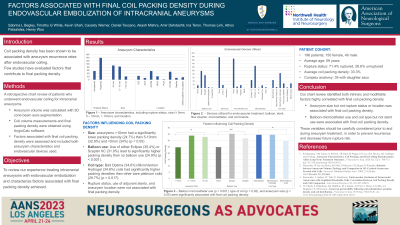Factors Associated with Final Coil Packing Density During the Endovascular Embolization of Intracranial Aneurysms
Friday, April 21, 2023


Sabrina Begley (she/her/hers)
Medical Student
Department of Neurosurgery, Zucker School of Medicine at Hofstra/Northwell
Bayside, New York, United States
ePoster Presenter(s)
Introduction: Coil packing density (CPD) has been repeatedly shown to be associated with aneurysm recurrence rates after endovascular coiling. Few studies have evaluated factors that contribute to final CPD. We describe our experience with factors associated with CPD.
Methods: A retrospective chart review of all patients undergoing endovascular coiling for intracranial aneurysms at a single institution was done. Aneurysm volume was calculated using 3D cone beam CT auto-segmentation. Factors associated with final coil packing density were assessed. Coil volume measurements were obtained using AngioCalc software and final CPDs were determined.
Results: A total of 197 aneurysms were treated with endovascular coiling. The majority of aneurysms were ruptured (71.6%). Average coiling packing density was 33%. Balloon microcatheter use, type of coil, and aneurysm size were significantly associated with final coil packing density (P < 0.05). Large aneurysms as defined by >10mm in greatest diameter had an average coil packing density of 24.7% which was lower than that of aneurysms 0-5mm (34%), and 5-10mm (32.9%) [P=0.05]. Balloon use was highly correlated with final packing density (P=0.0004). Lack of balloon microcatheter use led to an average packing density of 24.9%, CPD with the Scepter XC balloon was 31.9%, and CPD with the Eclipse balloon was 35.4%. Type of coil was also correlated with final packing density with Balt Optima coils (34.6%) and Hydrogel coils (34.6%) both having higher average packing densities than other bare metal platinum coils (29.7%) [p=0.017]. Rupture status, use of adjuvant stent, and aneurysm location were not associated with final CPD.
Conclusion : Balloon microcatheter use and type of coil are modifying factors that are highly correlated with final coil packing density. These variables should be considered carefully for aneurysm treatment.
Methods: A retrospective chart review of all patients undergoing endovascular coiling for intracranial aneurysms at a single institution was done. Aneurysm volume was calculated using 3D cone beam CT auto-segmentation. Factors associated with final coil packing density were assessed. Coil volume measurements were obtained using AngioCalc software and final CPDs were determined.
Results: A total of 197 aneurysms were treated with endovascular coiling. The majority of aneurysms were ruptured (71.6%). Average coiling packing density was 33%. Balloon microcatheter use, type of coil, and aneurysm size were significantly associated with final coil packing density (P < 0.05). Large aneurysms as defined by >10mm in greatest diameter had an average coil packing density of 24.7% which was lower than that of aneurysms 0-5mm (34%), and 5-10mm (32.9%) [P=0.05]. Balloon use was highly correlated with final packing density (P=0.0004). Lack of balloon microcatheter use led to an average packing density of 24.9%, CPD with the Scepter XC balloon was 31.9%, and CPD with the Eclipse balloon was 35.4%. Type of coil was also correlated with final packing density with Balt Optima coils (34.6%) and Hydrogel coils (34.6%) both having higher average packing densities than other bare metal platinum coils (29.7%) [p=0.017]. Rupture status, use of adjuvant stent, and aneurysm location were not associated with final CPD.
Conclusion : Balloon microcatheter use and type of coil are modifying factors that are highly correlated with final coil packing density. These variables should be considered carefully for aneurysm treatment.
